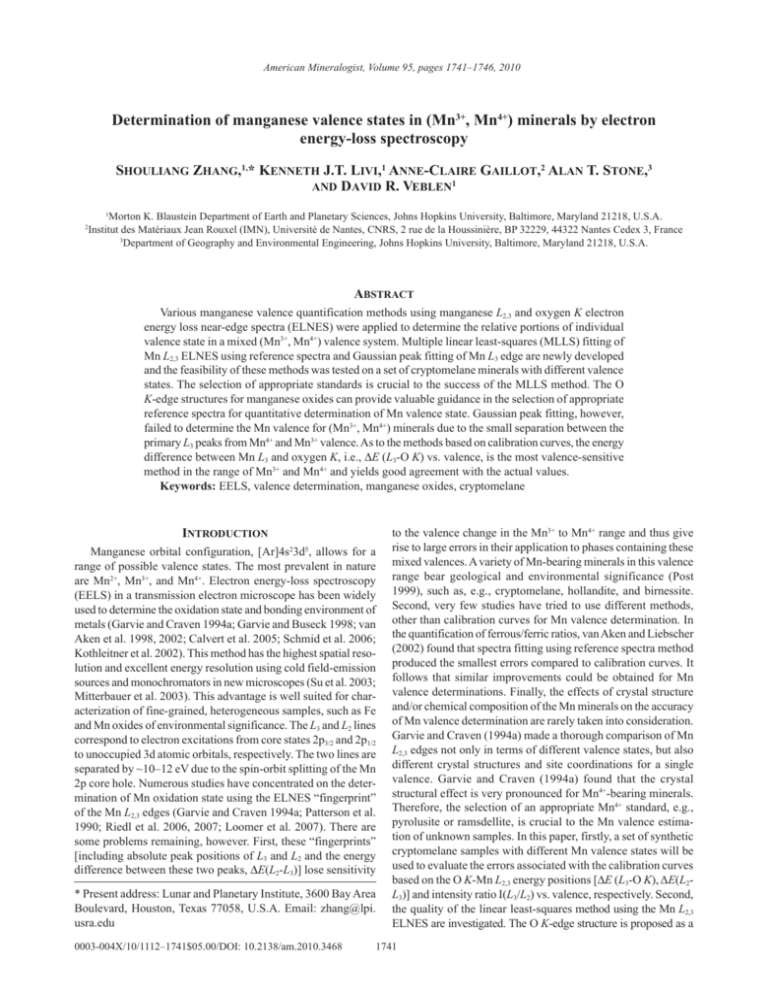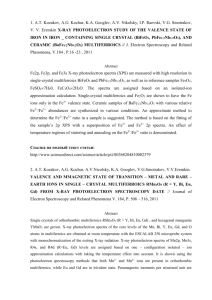Determination of manganese valence states in (Mn3+, Mn4+
advertisement

American Mineralogist, Volume 95, pages 1741–1746, 2010 Determination of manganese valence states in (Mn3+, Mn4+) minerals by electron energy-loss spectroscopy Shouliang Zhang,1,* Kenneth J.T. Livi,1 Anne-Claire Gaillot,2 Alan T. Stone,3 and David R. Veblen1 1 Morton K. Blaustein Department of Earth and Planetary Sciences, Johns Hopkins University, Baltimore, Maryland 21218, U.S.A. Institut des Matériaux Jean Rouxel (IMN), Université de Nantes, CNRS, 2 rue de la Houssinière, BP 32229, 44322 Nantes Cedex 3, France 3 Department of Geography and Environmental Engineering, Johns Hopkins University, Baltimore, Maryland 21218, U.S.A. 2 Abstract Various manganese valence quantification methods using manganese L2,3 and oxygen K electron energy loss near-edge spectra (ELNES) were applied to determine the relative portions of individual valence state in a mixed (Mn3+, Mn4+) valence system. Multiple linear least-squares (MLLS) fitting of Mn L2,3 ELNES using reference spectra and Gaussian peak fitting of Mn L3 edge are newly developed and the feasibility of these methods was tested on a set of cryptomelane minerals with different valence states. The selection of appropriate standards is crucial to the success of the MLLS method. The O K-edge structures for manganese oxides can provide valuable guidance in the selection of appropriate reference spectra for quantitative determination of Mn valence state. Gaussian peak fitting, however, failed to determine the Mn valence for (Mn3+, Mn4+) minerals due to the small separation between the primary L3 peaks from Mn4+ and Mn3+ valence. As to the methods based on calibration curves, the energy difference between Mn L3 and oxygen K, i.e., ∆E (L3-O K) vs. valence, is the most valence-sensitive method in the range of Mn3+ and Mn4+ and yields good agreement with the actual values. Keywords: EELS, valence determination, manganese oxides, cryptomelane Introduction Manganese orbital configuration, [Ar]4s 3d , allows for a range of possible valence states. The most prevalent in nature are Mn2+, Mn3+, and Mn4+. Electron energy-loss spectroscopy (EELS) in a transmission electron microscope has been widely used to determine the oxidation state and bonding environment of metals (Garvie and Craven 1994a; Garvie and Buseck 1998; van Aken et al. 1998, 2002; Calvert et al. 2005; Schmid et al. 2006; Kothleitner et al. 2002). This method has the highest spatial resolution and excellent energy resolution using cold field-emission sources and monochromators in new microscopes (Su et al. 2003; Mitterbauer et al. 2003). This advantage is well suited for characterization of fine-grained, heterogeneous samples, such as Fe and Mn oxides of environmental significance. The L3 and L2 lines correspond to electron excitations from core states 2p3/2 and 2p1/2 to unoccupied 3d atomic orbitals, respectively. The two lines are separated by ~10–12 eV due to the spin-orbit splitting of the Mn 2p core hole. Numerous studies have concentrated on the determination of Mn oxidation state using the ELNES “fingerprint” of the Mn L2,3 edges (Garvie and Craven 1994a; Patterson et al. 1990; Riedl et al. 2006, 2007; Loomer et al. 2007). There are some problems remaining, however. First, these “fingerprints” [including absolute peak positions of L3 and L2 and the energy difference between these two peaks, ∆E(L2-L3)] lose sensitivity 2 5 * Present address: Lunar and Planetary Institute, 3600 Bay Area Boulevard, Houston, Texas 77058, U.S.A. Email: zhang@lpi. usra.edu 0003-004X/10/1112–1741$05.00/DOI: 10.2138/am.2010.3468 to the valence change in the Mn3+ to Mn4+ range and thus give rise to large errors in their application to phases containing these mixed valences. A variety of Mn-bearing minerals in this valence range bear geological and environmental significance (Post 1999), such as, e.g., cryptomelane, hollandite, and birnessite. Second, very few studies have tried to use different methods, other than calibration curves for Mn valence determination. In the quantification of ferrous/ferric ratios, van Aken and Liebscher (2002) found that spectra fitting using reference spectra method produced the smallest errors compared to calibration curves. It follows that similar improvements could be obtained for Mn valence determinations. Finally, the effects of crystal structure and/or chemical composition of the Mn minerals on the accuracy of Mn valence determination are rarely taken into consideration. Garvie and Craven (1994a) made a thorough comparison of Mn L2,3 edges not only in terms of different valence states, but also different crystal structures and site coordinations for a single valence. Garvie and Craven (1994a) found that the crystal structural effect is very pronounced for Mn4+-bearing minerals. Therefore, the selection of an appropriate Mn4+ standard, e.g., pyrolusite or ramsdellite, is crucial to the Mn valence estimation of unknown samples. In this paper, firstly, a set of synthetic cryptomelane samples with different Mn valence states will be used to evaluate the errors associated with the calibration curves based on the O K-Mn L2,3 energy positions [∆E (L3-O K), ΔE(L2L3)] and intensity ratio I(L3/L2) vs. valence, respectively. Second, the quality of the linear least-squares method using the Mn L2,3 ELNES are investigated. The O K-edge structure is proposed as a 1741






